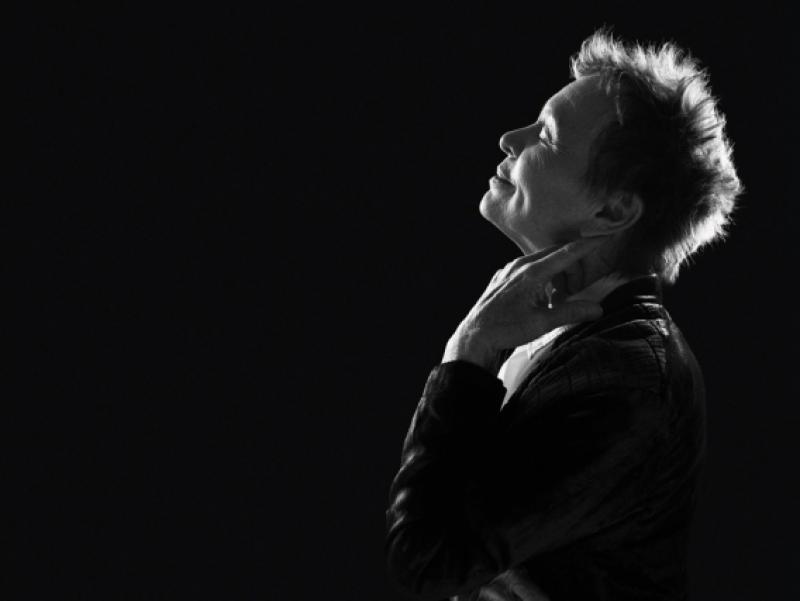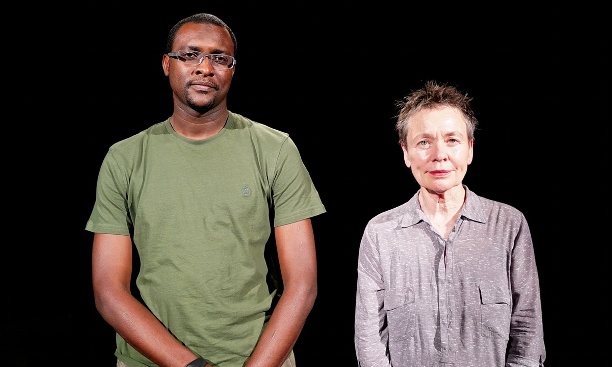Brighton Festival: Laurie Anderson - Slideshow, Brighton Dome | reviews, news & interviews
Brighton Festival: Laurie Anderson - Slideshow, Brighton Dome
Brighton Festival: Laurie Anderson - Slideshow, Brighton Dome
The great performance-artist riffs superbly on stories, space and home

Brighton Festival’s guest director speaks in a sort of rapid-fire drawl, ideal for her debut as a stand-up comic, which she claims was tonight’s Plan A. This half-century veteran of performance art is more slippery than that, proffering a discursive, unreliable, funny and profound master-class in shaggy-dog philosophy, with the festival’s theme of home at its arguable core.
The hit single “O Superman” was Laurie Anderson’s vital calling-card to pop culture, her marriage to Lou Reed a brief downtown New York art nirvana, addressed elsewhere in the festival. But the life she zigzags through tonight is one of gratefully seized opportunities and extraordinary adventures, undertaken by a brilliant nebbish. This charmingly self-deprecating character puts the phone down on NASA when they ask her to be their artist-in-residence. Once she’s believed her luck, she finds herself in the control room as contact is made with Mars probes, and observes scientists imagine “giant art projects” she envies, and con the public with beautifully coloured, painterly photos from colourless outer space, because “we thought people would like it”. In a digital version of the old-fashioned show-and-tell of tonight’s Slideshow title, pictures and film mirror and counterpoint her finely modulated yarns.
 There are two jokes, one excellent, told with Woody Allen timing. And there are fascinating digressions, from a summary of Aristophanes’ The Birds to the life of Leo Marks, of the bookselling family immortalised in 84 Charing Cross Road, as a World War Two poet-cryptographer. Anderson’s own attempted solitude in a hellish Amish kitchen, and on a river with a garrulous incest survivor group (“Martyrs and control freaks and sad people and...losers” too close to herself), are tales so tall they’re surely, with however much gonzo garnish, true.
There are two jokes, one excellent, told with Woody Allen timing. And there are fascinating digressions, from a summary of Aristophanes’ The Birds to the life of Leo Marks, of the bookselling family immortalised in 84 Charing Cross Road, as a World War Two poet-cryptographer. Anderson’s own attempted solitude in a hellish Amish kitchen, and on a river with a garrulous incest survivor group (“Martyrs and control freaks and sad people and...losers” too close to herself), are tales so tall they’re surely, with however much gonzo garnish, true.
Truth, home and memory are investigated as Anderson ranges through a Midwest childhood which seems a greater clue to her character than the decades in New York. One of eight siblings left to their own devices (she and a sister make their own sandwiches, leave then return to marvel at their mum’s thoughtfulness), she almost drowns her twin brothers when their pram sinks under a lake’s cracked ice, but dives down to save them. Headstrong, fearless and attention-seeking, a back-flip from a diving-board aged 12 hits concrete, not water, and a doctor tells her she’ll never walk again. This teaches her to disbelieve authority. But as she sinks into her personal mythology’s painful reality, she disbelieves it too. “Your story – you hold onto it,” she says. “And every time you tell it, you forget it, more.” Back turned, she plays her treated violin, and snow falls on a melancholy, wooded scene.
The closing passage of a near-two-hour show which gets half-way through her intended subjects homes in on the word “home”, co-opted by the Department of Homeland Security. The tone darkens greatly as she explains Habeas Corpus, an artwork made in collaboration with Mohammed al Gharani, pictured above with Anderson, a Saudi computer student held and tortured among Guantanamo’s innocent and suicides for seven years. The jet-black, grubby evil of the way her nation operates, even as it produces shining lights like Laurie Anderson, is her final thought on home.
rating
Explore topics
Share this article
The future of Arts Journalism
You can stop theartsdesk.com closing!
We urgently need financing to survive. Our fundraising drive has thus far raised £49,000 but we need to reach £100,000 or we will be forced to close. Please contribute here: https://gofund.me/c3f6033d
And if you can forward this information to anyone who might assist, we’d be grateful.

Subscribe to theartsdesk.com
Thank you for continuing to read our work on theartsdesk.com. For unlimited access to every article in its entirety, including our archive of more than 15,000 pieces, we're asking for £5 per month or £40 per year. We feel it's a very good deal, and hope you do too.
To take a subscription now simply click here.
And if you're looking for that extra gift for a friend or family member, why not treat them to a theartsdesk.com gift subscription?
more New music
 Music Reissues Weekly: The Outer Limits - Just One More Chance
Exhaustive anthology unearths the full story of the Sixties mod-pop band from Leeds
Music Reissues Weekly: The Outer Limits - Just One More Chance
Exhaustive anthology unearths the full story of the Sixties mod-pop band from Leeds
 theartsdesk Radio Show 37 - Pete Lawrence of the Big Chill discusses the power of protest music and his new project This Is The Fire
Talking to cultural activist Pete Lawrence – camp outs, singalongs and saving the world
theartsdesk Radio Show 37 - Pete Lawrence of the Big Chill discusses the power of protest music and his new project This Is The Fire
Talking to cultural activist Pete Lawrence – camp outs, singalongs and saving the world
 Album: Sabrina Carpenter - Man's Best Friend
Short but not so sweet
Album: Sabrina Carpenter - Man's Best Friend
Short but not so sweet
 Album: CMAT - EURO-COUNTRY
The flame-headed chanteuse with the comic touch hits pop perfection
Album: CMAT - EURO-COUNTRY
The flame-headed chanteuse with the comic touch hits pop perfection
 Album: The Hives - The Hives Forever, Forever The Hives
No power ballads, no acoustic interludes - just speedy rock’n’roll all the way
Album: The Hives - The Hives Forever, Forever The Hives
No power ballads, no acoustic interludes - just speedy rock’n’roll all the way
 Album: Benedicte Maurseth - Mirra
Haunting, intense evocation of Norway’s uplands and its wildlife
Album: Benedicte Maurseth - Mirra
Haunting, intense evocation of Norway’s uplands and its wildlife
 Album: Nova Twins - Parasites & Butterflies
Exciting London duo turn inward and more introspective with their third album while retaining their trademark hybrid sound
Album: Nova Twins - Parasites & Butterflies
Exciting London duo turn inward and more introspective with their third album while retaining their trademark hybrid sound
 Music Reissues Weekly: The Beatles - What's The New, Mary Jane
John Lennon’s queasy, see-sawing oddity becomes the subject of a whole album
Music Reissues Weekly: The Beatles - What's The New, Mary Jane
John Lennon’s queasy, see-sawing oddity becomes the subject of a whole album
 The Maccabees, Barrowland, Glasgow review - indie band return with both emotion and quality
The five-piece's reunion showed their music has stood the test of time.
The Maccabees, Barrowland, Glasgow review - indie band return with both emotion and quality
The five-piece's reunion showed their music has stood the test of time.
 Album: Blood Orange - Essex Honey
A triumph for the artist who doesn't clamour for attention but just keeps growing
Album: Blood Orange - Essex Honey
A triumph for the artist who doesn't clamour for attention but just keeps growing
 Houghton / We Out Here festivals review - an ultra-marathon of community vibes
Two different but overlapping flavours of subculture full of vigour
Houghton / We Out Here festivals review - an ultra-marathon of community vibes
Two different but overlapping flavours of subculture full of vigour
 Album: Wolf Alice - Clearing
Ten years from their debut, Wolf Alice once again make magic from the familiar
Album: Wolf Alice - Clearing
Ten years from their debut, Wolf Alice once again make magic from the familiar

Add comment